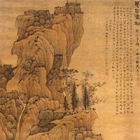Asian Gallery (Toyokan) Room 8
January 2, 2016 (Sat) - February 14, 2016 (Sun)
Lan Ying (1585–1664, according to one possibility) was a prominent painter of the late Ming period. Born in Hangzhou, Zhejiang province, he grew tired of studying painting in this area and began travelling around Jiangnan to further his learning. Gaining the favor of leading Jiangnan literati such as Dong Qichang and Chen Jiru, he studied the classical works in their collections and the philosophy behind literati painting. He returned to Hangzhou in his later years and gave instruction to numerous pupils.
Lan Ying created a new style by integrating the grand compositional techniques of the traditional Zhe school based in Hangzhou with the elegant literati painting that was popular in Jiangnan. His style was inherited by family and pupils, and came to be known as the "Wulin" school (Wulin was the old name for Hangzhou). Lang Ying is therefore known as both "the last of the Zhe school" and "the founder of the Wulin school."
His noteworthy style was inherited by many pupils including his son, Lan Meng, and grandson, Lan Tao, as well as Sun Di and the brothers Zhang Gu and Zhang Cai.
This style possesses a unique quality that makes paintings of the Wulin school instantly recognizable. It is also well known that many of Lan Ying's works were brought to Japan in the Edo period (1603–1868), where they had an influence on Japanese literati painters such as Tani Buncho.
This exhibition is the very first of its kind in Japan, providing an overview of Lan Ying and the Wulin school.

